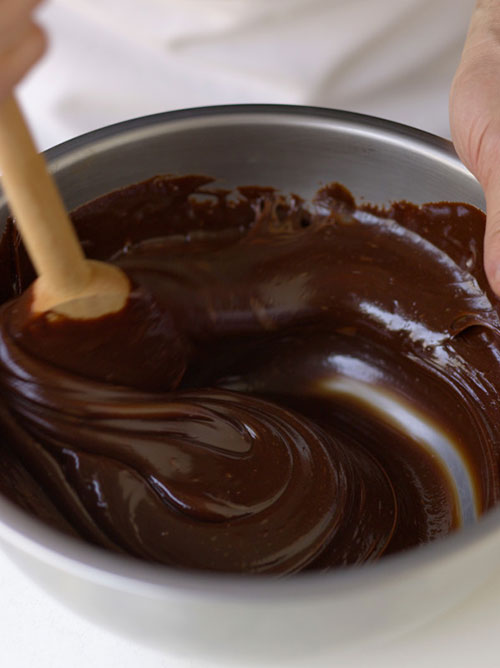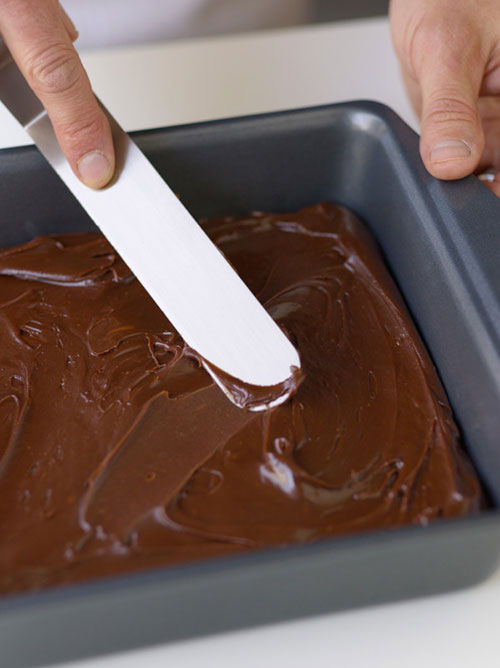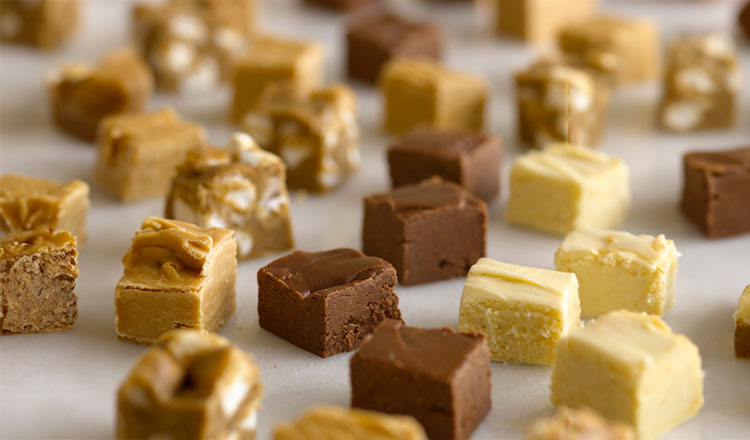Fudge is without question the quintessential homemade candy; it has been made in home kitchens for over 100 years. Mention fudge, and most of us immediately think of chocolate, but chocolate is not the defining ingredient in fudge; it can be made using a wide variety of flavoring ingredients.
The precise origin of fudge is not entirely clear, but it is believed to have originated from a batch of caramels gone awry—“fudged,” if you will! This seems surprising at first glance, because caramels and fudge have such different textures that they seem to be completely unrelated. The ingredients, cooking temperatures, and techniques for making fudge and caramel, however, are nearly identical. It is only after cooking that fudge is stirred rapidly to cause it to crystallize, giving it its short texture, whereas caramels are allowed to cool undisturbed to prevent the sugar from crystallizing, resulting in their chewy texture.
What’s in it?
Fudge contains virtually the same ingredients as soft caramels, although usually not in precisely the same proportions. Because crystallization of the sugar is the desired result when making fudge, it usually contains less corn syrup, which hinders crystallization, than do caramels. In addition, fudge often has inclusions such as nuts, dried fruit, and marshmallows that are added for textural and flavor contrast.
SUGAR
Fudge is a sugar-based confection, so it comes as no surprise that it contains a high percentage of sugar. Cane or beet sugar (sucrose) is the sugar that crystallizes, providing the characteristic texture of the candy.
CORN SYRUP
Although we want our fudge to crystallize, fudge contains corn syrup to help slow down and control that crystallization. Without the “doctoring” effect of corn syrup, most batches of fudge would end up as rock-hard, sugary boulders before we could get them into pans! In addition to allowing extra time to work with fudge, corn syrup helps create smaller crystals of sugar, leading to a smooth texture rather than a grainy one.
DAIRY PRODUCT
Good-quality fudge always contains dairy products, either fresh or processed. The dairy product provides flavor, both from the product itself and from Maillard browning, creating a caramel-like flavor. Dairy products also contain fat, which makes a richer, more satisfying candy.
The advantage of processed products such as sweetened condensed milk or evaporated milk is that they contain more of the desired milk solids and less water, which must be evaporated during cooking. When made with fresh dairy products, fudge will take much longer to cook to remove the extra water.
FLAVORING
Although fudge can be flavored with manufactured flavors, it is much more common for it to get its flavor from foods like chocolate or peanut butter. Most often the flavoring is added after cooking, when stirring begins. Many of the flavoring ingredients in fudge contain fat as well as sugar, so each fudge recipe is carefully balanced for that flavor. Substituting flavoring ingredients in fudge recipes seldom gives desirable results unless other elements of the recipe are also changed.
FRAPPE
Frappe is an optional ingredient sometimes used when making fudge. Frappe is essentially a meringue and is used to lighten the texture of the fudge. Fudge made using frappe is typically softer and smoother than one made without it.
INCLUSIONS
There are few limits to the types and varieties of inclusions that can be used to bolster the appeal of fudge. From nuts and seeds to dried or candied fruit, or to candies such as hard candy or marshmallows, the combinations are limitless. The only real requirement for an inclusion is that it must not be a perishable item like fresh fruit. Adding inclusions that are not shelf stable will cause fudge to spoil rapidly. So choose any of the nonperishable products that you want and add them to your fudge recipe to create your own unique treat!
How it’s Made
Making fudge is a simple matter of cooking the batch to the correct temperature, allowing it to cool undisturbed, and then stirring it vigorously until it takes on a creamy appearance.
In professional candy shops, the batch is cooled on a thick stone tabletop and the stirring is replaced by agitation (repeated turning) on the marble. At home, usually the batch is cooled in a baking pan and crystallization is accomplished by vigorous stirring in a bowl with a spoon. The true art to fudge making is the amount of stirring: too little, and your fudge will have a sugary texture; too much, and the fudge will harden in the bowl rather than in the pan.


- Combine the sugar, corn syrup, and dairy products and stir while cooking. Use moderate heat to prevent scorching or boiling over.
- Cook to the specified temperature. The temperature is crucial. Use an accurate thermometer.
- Remove from the heat and pour into a baking pan to cool. Pouring into a pan cools the batch faster.
- Allow the batch to cool without stirring. Fudge recipes should specify a length of time to cool or a desired temperature.
- Transfer the cooked batch to a bowl and add flavoring and inclusions. These are nearly always added after cooking so as not to damage them.
- Stir until creamy. This takes some experience to get right, but 3 to 5 minutes of vigorous stirring with a wooden spoon is usually adequate.
- Pour into a prepared pan. Buttered baking pans are commonly used for fudge.
- Allow to harden. Fudge usually sets within 30 minutes of spreading into the pan.
- Slice and serve. Like most homemade products, fudge is at its best when served fresh.
Did you know?
The first reliable documentation of fudge being made intentionally indicates that it was made and sold by women enrolled at Vassar College in Poughkeepsie, New York in 1888. These students may not have been the original creators of the candy, but they were certainly among the first. Did the Vassar students also give fudge its name? Again, no one can be sure, but it certainly seems plausible. Dictionaries of the time defined “fudge” as a noun meaning “nonsense” or a verb meaning to “fake it.” Either one seems fitting for a candy that turned out as it did quite by accident.


